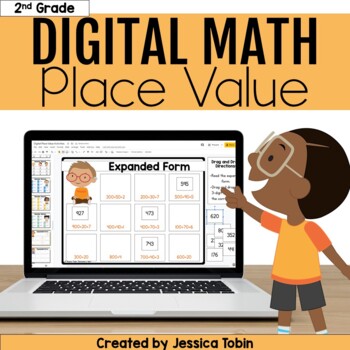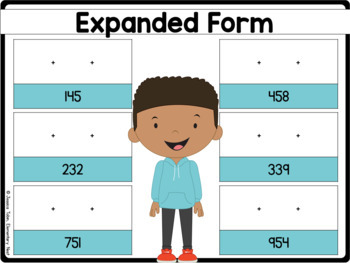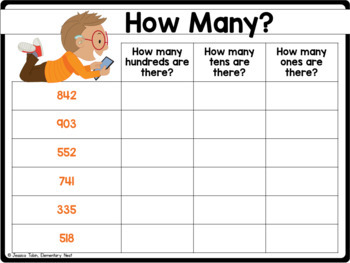Place Value Digital Games Activities - 2nd Grade Math Place Value Google Slides
- PDF
- Google Apps™
- Internet Activities

What educators are saying
Description
This is a digital math activity for place value. The activities come ready-made in Google Slides. The resource aligns with a few of the 2nd grade Common Core Math Standards in the Numbers and Operations in Base Ten (NBT). Topics covered are place values (hundreds, tens, ones), base-ten blocks, expanded form, number names, representing numbers, skip counting by 5s, 10s, and 100s, and comparing numbers.
When you download the file, you will open a PDF. The link to Google Slides is available on page 4 of this PDF file. Please read through the instructions and guided pages to learn how to open, save, and share with your students.
- A page with instructions on how to save the PowerPoint version is also added into the PDF. This would be for teachers wanting to upload pages to their own Seesaw, Canvas, or other platforms outside of Google Slides.
Activities Included:
- Base-Ten Blocks- Tens
- Base-Ten Blocks- Hundreds
- Base-Ten Blocks- 2-Digit Numbers
- Base-Ten Blocks- 3-Digit Numbers
- How Many H/T/O?
- What’s the Value? H/T/O
- Skip Counting by 5s
- Skip Counting by 10s
- Skip Counting by 100s
- Multiple Choice- Skip Counting
- Number Names- Matching
- Number Names- Typing
- Number Names- Multiple Choice
- Number Names- Typing 2
- Expanded Form- Matching
- Expanded Form- Dragging H/T/O
- Expanded Form- Type It Out
- Expanded Form- Type It Out
- Representing Numbers in 3 Ways
- Comparing Numbers- Drag Symbols
Standards Covered:
- 2.NBT.1- Understand that the three digits of a three-digit number represent amounts of hundreds, tens, and ones; e.g., 706 equals 7 hundreds, 0 tens, and 6 ones.
- 2.NBT.2- Count within 1000; skip-count by 5s, 10s, and 100s.
- 2.NBT.3- Read and write numbers to 1000 using base-ten numerals, number names, and expanded form.
- 2.NBT.4- Compare two three-digit numbers based on meanings of the hundreds, tens, and ones digits, using >, =, and < symbols to record the results of comparisons.
For the full NBT units, check these standards-aligned lesson sets:
This resource includes 63 slides on language practice.
This purchase is for one single classroom only.
If you're interested in sharing with other classrooms, make sure to buy the extra licenses for a discount through the TeachersPayTeachers tool. If you are interested in a site license, please contact me for a quote at jessica.L.tobin@gmail.com.





